Menu Development, Planning and Design
VerifiedAdded on 2023/01/13
|13
|2858
|47
AI Summary
This document discusses the principles of menu planning and design, customer and business requirements, costing and pricing menus, and the development of a menu that benefits both customers and the organization. It provides insights into the factors to consider when planning a menu and offers strategies for maximizing profits and meeting customer expectations. The document also includes an evaluation of menu performance and key performance indicators for food enterprises.
Contribute Materials
Your contribution can guide someone’s learning journey. Share your
documents today.
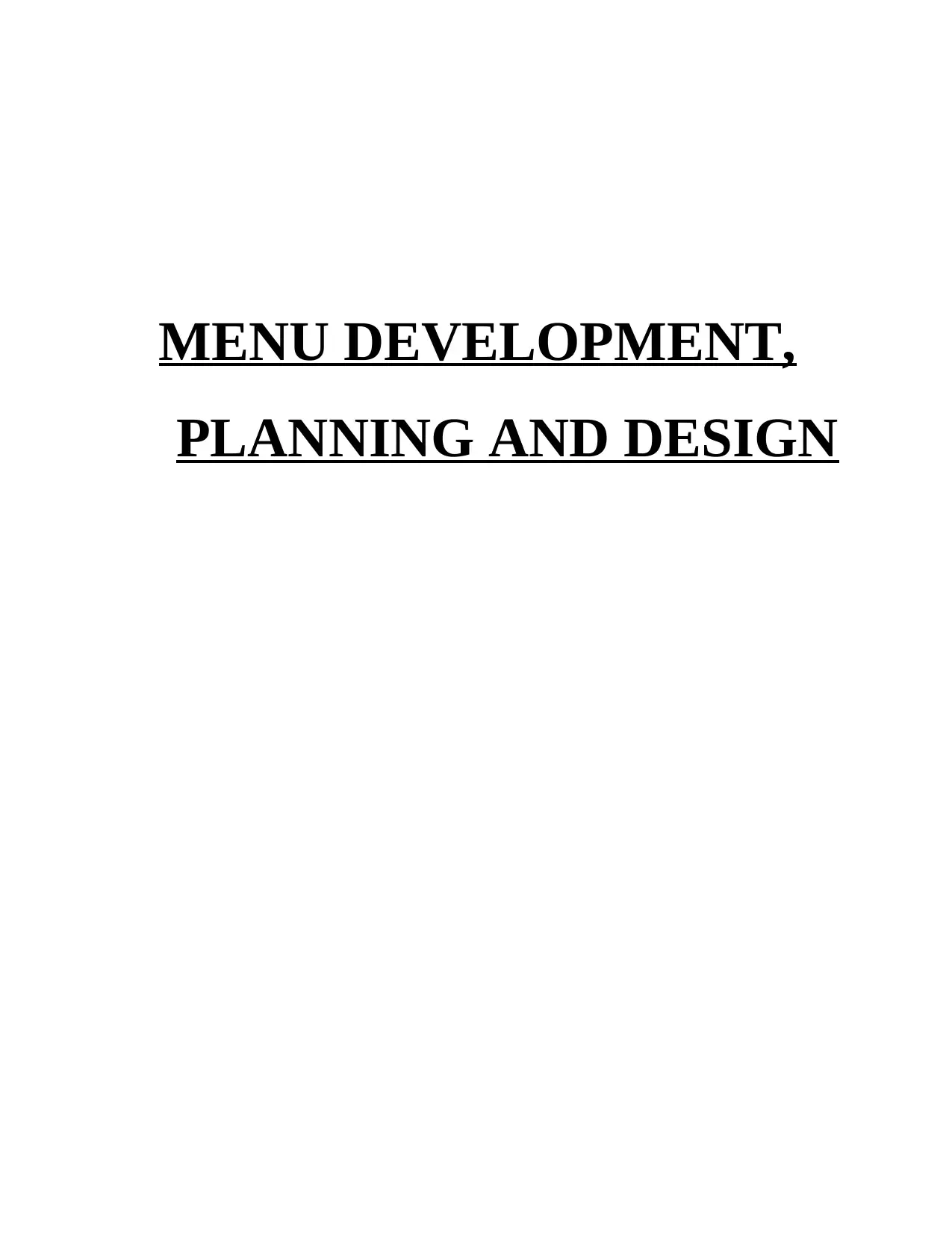
MENU DEVELOPMENT,
PLANNING AND DESIGN
PLANNING AND DESIGN
Secure Best Marks with AI Grader
Need help grading? Try our AI Grader for instant feedback on your assignments.
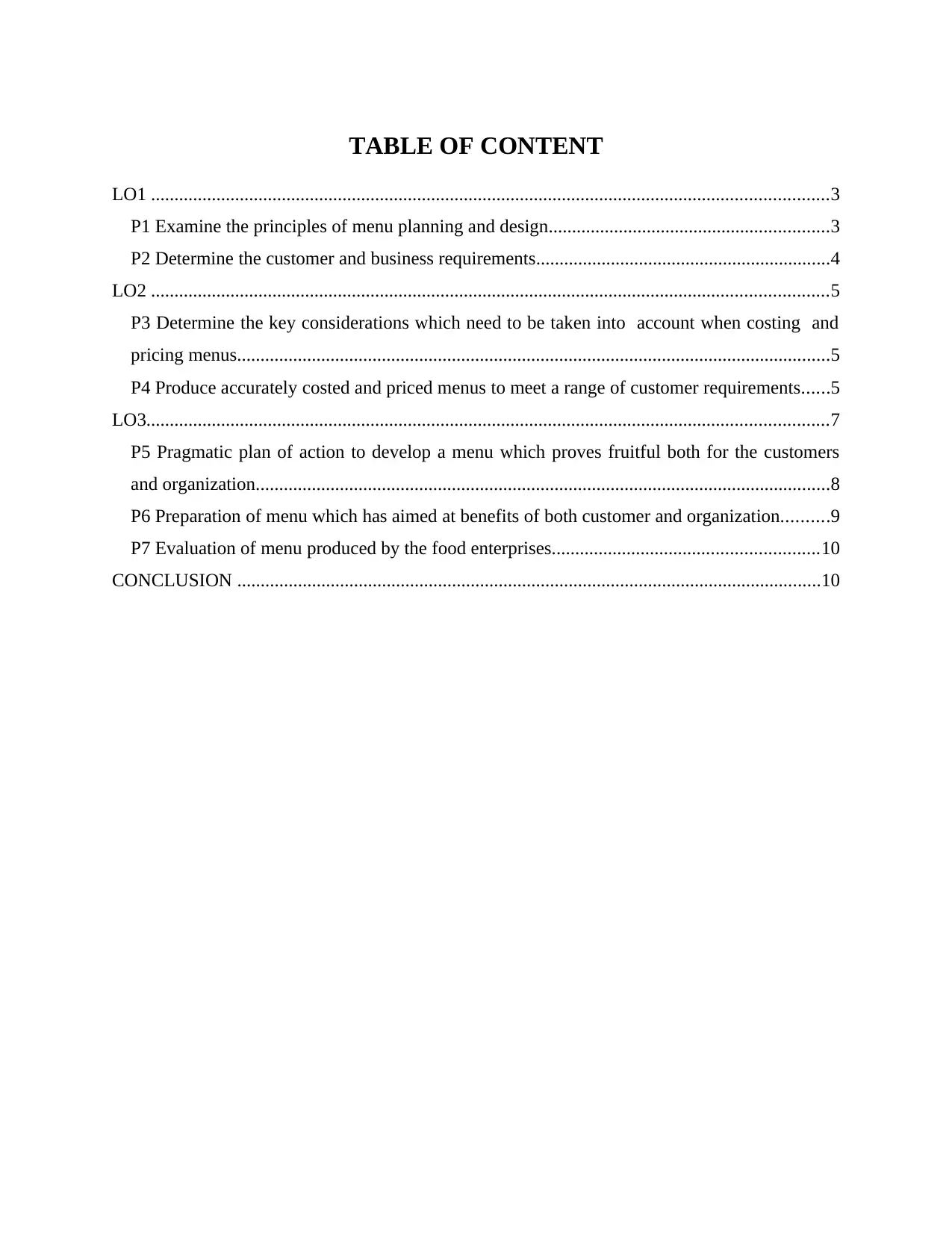
TABLE OF CONTENT
LO1 .................................................................................................................................................3
P1 Examine the principles of menu planning and design............................................................3
P2 Determine the customer and business requirements...............................................................4
LO2 .................................................................................................................................................5
P3 Determine the key considerations which need to be taken into account when costing and
pricing menus...............................................................................................................................5
P4 Produce accurately costed and priced menus to meet a range of customer requirements......5
LO3..................................................................................................................................................7
P5 Pragmatic plan of action to develop a menu which proves fruitful both for the customers
and organization...........................................................................................................................8
P6 Preparation of menu which has aimed at benefits of both customer and organization..........9
P7 Evaluation of menu produced by the food enterprises.........................................................10
CONCLUSION .............................................................................................................................10
LO1 .................................................................................................................................................3
P1 Examine the principles of menu planning and design............................................................3
P2 Determine the customer and business requirements...............................................................4
LO2 .................................................................................................................................................5
P3 Determine the key considerations which need to be taken into account when costing and
pricing menus...............................................................................................................................5
P4 Produce accurately costed and priced menus to meet a range of customer requirements......5
LO3..................................................................................................................................................7
P5 Pragmatic plan of action to develop a menu which proves fruitful both for the customers
and organization...........................................................................................................................8
P6 Preparation of menu which has aimed at benefits of both customer and organization..........9
P7 Evaluation of menu produced by the food enterprises.........................................................10
CONCLUSION .............................................................................................................................10
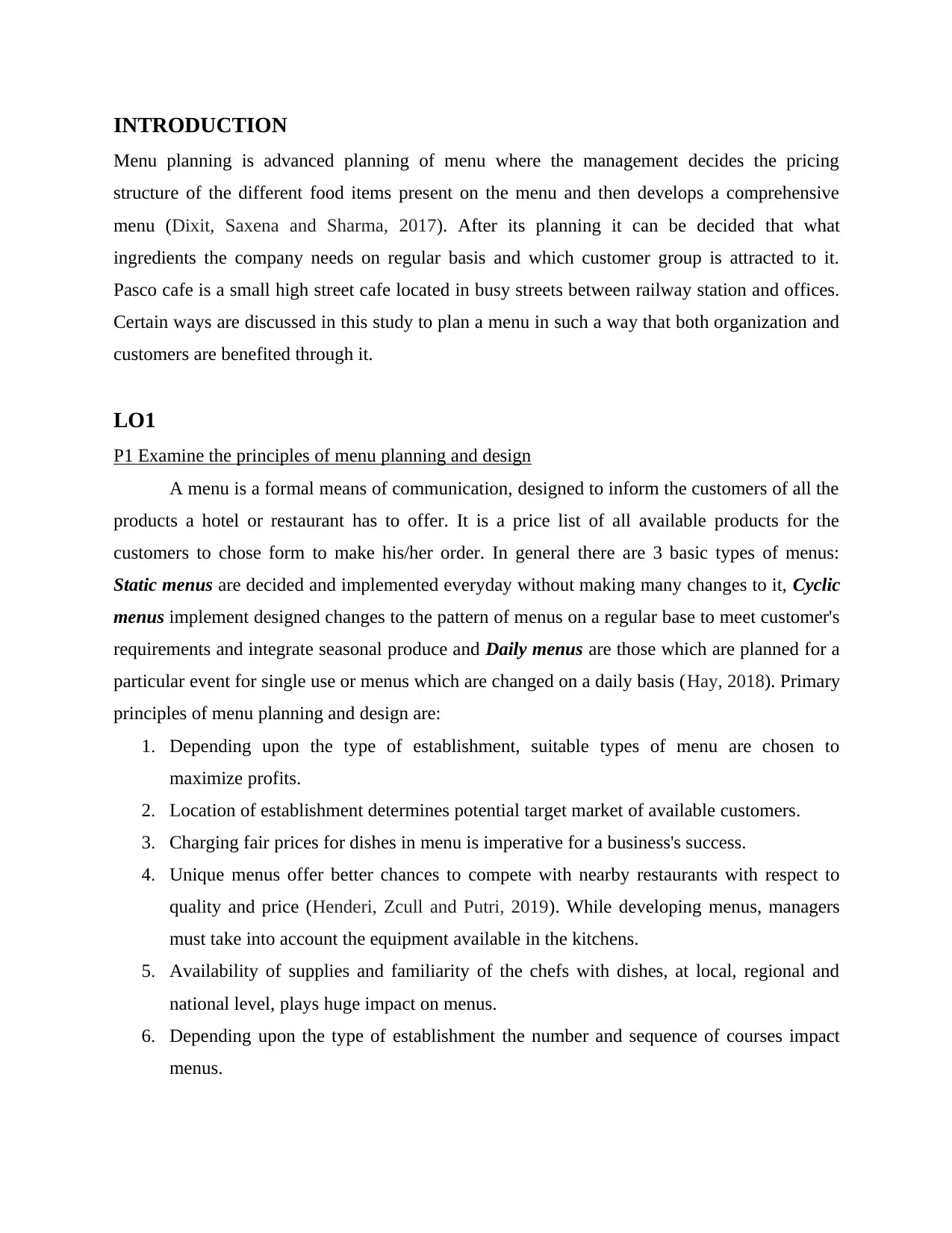
INTRODUCTION
Menu planning is advanced planning of menu where the management decides the pricing
structure of the different food items present on the menu and then develops a comprehensive
menu (Dixit, Saxena and Sharma, 2017). After its planning it can be decided that what
ingredients the company needs on regular basis and which customer group is attracted to it.
Pasco cafe is a small high street cafe located in busy streets between railway station and offices.
Certain ways are discussed in this study to plan a menu in such a way that both organization and
customers are benefited through it.
LO1
P1 Examine the principles of menu planning and design
A menu is a formal means of communication, designed to inform the customers of all the
products a hotel or restaurant has to offer. It is a price list of all available products for the
customers to chose form to make his/her order. In general there are 3 basic types of menus:
Static menus are decided and implemented everyday without making many changes to it, Cyclic
menus implement designed changes to the pattern of menus on a regular base to meet customer's
requirements and integrate seasonal produce and Daily menus are those which are planned for a
particular event for single use or menus which are changed on a daily basis (Hay, 2018). Primary
principles of menu planning and design are:
1. Depending upon the type of establishment, suitable types of menu are chosen to
maximize profits.
2. Location of establishment determines potential target market of available customers.
3. Charging fair prices for dishes in menu is imperative for a business's success.
4. Unique menus offer better chances to compete with nearby restaurants with respect to
quality and price (Henderi, Zcull and Putri, 2019). While developing menus, managers
must take into account the equipment available in the kitchens.
5. Availability of supplies and familiarity of the chefs with dishes, at local, regional and
national level, plays huge impact on menus.
6. Depending upon the type of establishment the number and sequence of courses impact
menus.
Menu planning is advanced planning of menu where the management decides the pricing
structure of the different food items present on the menu and then develops a comprehensive
menu (Dixit, Saxena and Sharma, 2017). After its planning it can be decided that what
ingredients the company needs on regular basis and which customer group is attracted to it.
Pasco cafe is a small high street cafe located in busy streets between railway station and offices.
Certain ways are discussed in this study to plan a menu in such a way that both organization and
customers are benefited through it.
LO1
P1 Examine the principles of menu planning and design
A menu is a formal means of communication, designed to inform the customers of all the
products a hotel or restaurant has to offer. It is a price list of all available products for the
customers to chose form to make his/her order. In general there are 3 basic types of menus:
Static menus are decided and implemented everyday without making many changes to it, Cyclic
menus implement designed changes to the pattern of menus on a regular base to meet customer's
requirements and integrate seasonal produce and Daily menus are those which are planned for a
particular event for single use or menus which are changed on a daily basis (Hay, 2018). Primary
principles of menu planning and design are:
1. Depending upon the type of establishment, suitable types of menu are chosen to
maximize profits.
2. Location of establishment determines potential target market of available customers.
3. Charging fair prices for dishes in menu is imperative for a business's success.
4. Unique menus offer better chances to compete with nearby restaurants with respect to
quality and price (Henderi, Zcull and Putri, 2019). While developing menus, managers
must take into account the equipment available in the kitchens.
5. Availability of supplies and familiarity of the chefs with dishes, at local, regional and
national level, plays huge impact on menus.
6. Depending upon the type of establishment the number and sequence of courses impact
menus.
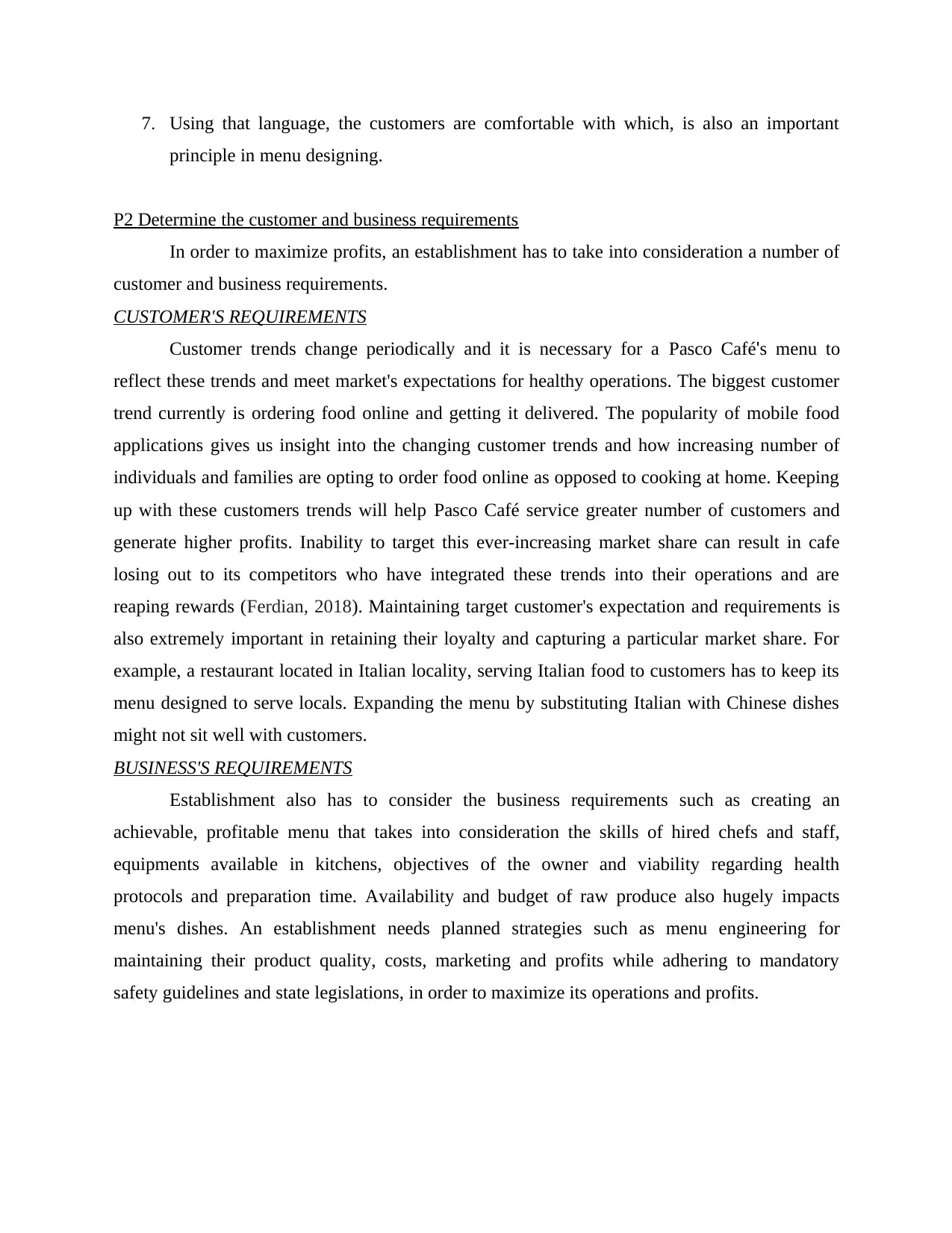
7. Using that language, the customers are comfortable with which, is also an important
principle in menu designing.
P2 Determine the customer and business requirements
In order to maximize profits, an establishment has to take into consideration a number of
customer and business requirements.
CUSTOMER'S REQUIREMENTS
Customer trends change periodically and it is necessary for a Pasco Café's menu to
reflect these trends and meet market's expectations for healthy operations. The biggest customer
trend currently is ordering food online and getting it delivered. The popularity of mobile food
applications gives us insight into the changing customer trends and how increasing number of
individuals and families are opting to order food online as opposed to cooking at home. Keeping
up with these customers trends will help Pasco Café service greater number of customers and
generate higher profits. Inability to target this ever-increasing market share can result in cafe
losing out to its competitors who have integrated these trends into their operations and are
reaping rewards (Ferdian, 2018). Maintaining target customer's expectation and requirements is
also extremely important in retaining their loyalty and capturing a particular market share. For
example, a restaurant located in Italian locality, serving Italian food to customers has to keep its
menu designed to serve locals. Expanding the menu by substituting Italian with Chinese dishes
might not sit well with customers.
BUSINESS'S REQUIREMENTS
Establishment also has to consider the business requirements such as creating an
achievable, profitable menu that takes into consideration the skills of hired chefs and staff,
equipments available in kitchens, objectives of the owner and viability regarding health
protocols and preparation time. Availability and budget of raw produce also hugely impacts
menu's dishes. An establishment needs planned strategies such as menu engineering for
maintaining their product quality, costs, marketing and profits while adhering to mandatory
safety guidelines and state legislations, in order to maximize its operations and profits.
principle in menu designing.
P2 Determine the customer and business requirements
In order to maximize profits, an establishment has to take into consideration a number of
customer and business requirements.
CUSTOMER'S REQUIREMENTS
Customer trends change periodically and it is necessary for a Pasco Café's menu to
reflect these trends and meet market's expectations for healthy operations. The biggest customer
trend currently is ordering food online and getting it delivered. The popularity of mobile food
applications gives us insight into the changing customer trends and how increasing number of
individuals and families are opting to order food online as opposed to cooking at home. Keeping
up with these customers trends will help Pasco Café service greater number of customers and
generate higher profits. Inability to target this ever-increasing market share can result in cafe
losing out to its competitors who have integrated these trends into their operations and are
reaping rewards (Ferdian, 2018). Maintaining target customer's expectation and requirements is
also extremely important in retaining their loyalty and capturing a particular market share. For
example, a restaurant located in Italian locality, serving Italian food to customers has to keep its
menu designed to serve locals. Expanding the menu by substituting Italian with Chinese dishes
might not sit well with customers.
BUSINESS'S REQUIREMENTS
Establishment also has to consider the business requirements such as creating an
achievable, profitable menu that takes into consideration the skills of hired chefs and staff,
equipments available in kitchens, objectives of the owner and viability regarding health
protocols and preparation time. Availability and budget of raw produce also hugely impacts
menu's dishes. An establishment needs planned strategies such as menu engineering for
maintaining their product quality, costs, marketing and profits while adhering to mandatory
safety guidelines and state legislations, in order to maximize its operations and profits.
Secure Best Marks with AI Grader
Need help grading? Try our AI Grader for instant feedback on your assignments.
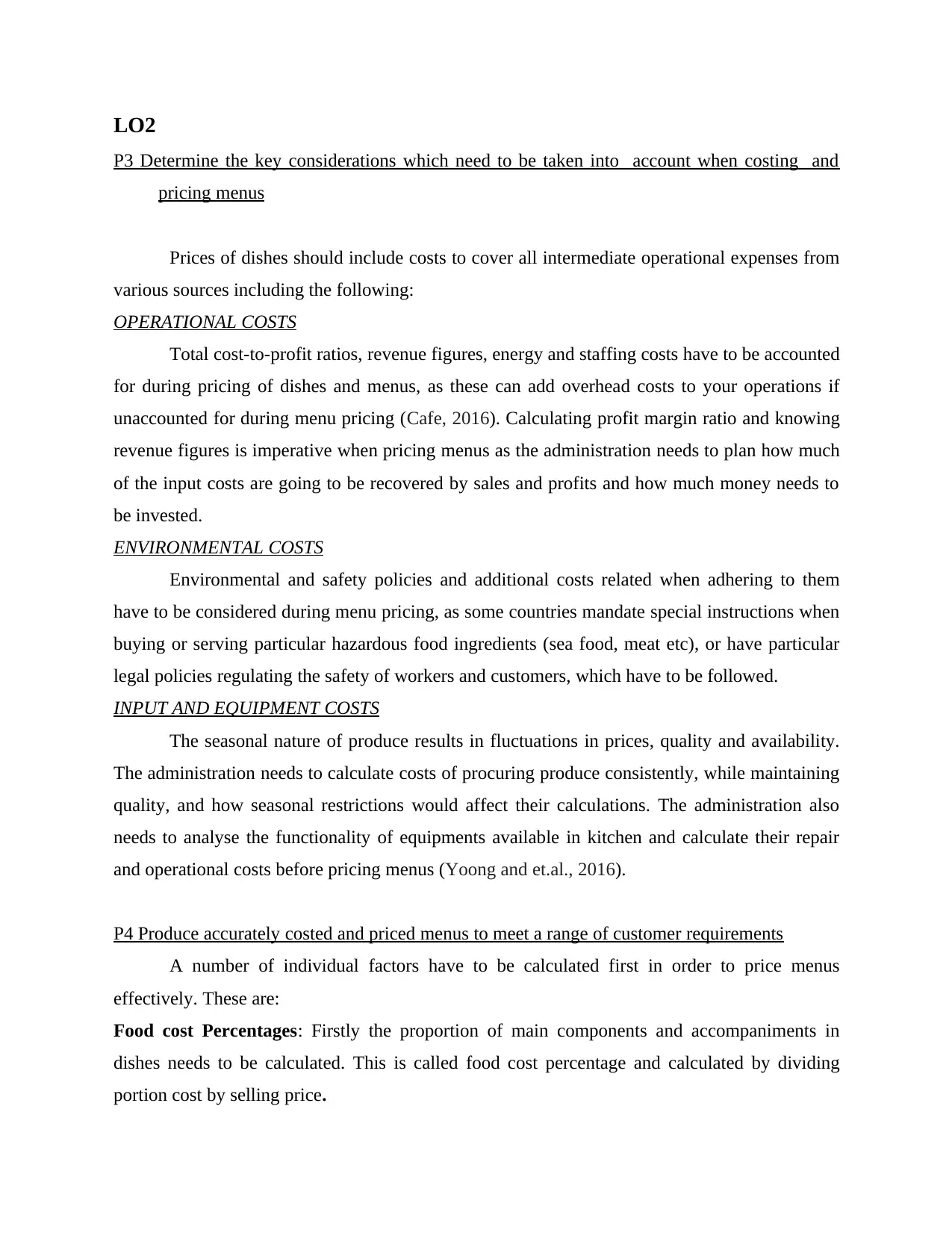
LO2
P3 Determine the key considerations which need to be taken into account when costing and
pricing menus
Prices of dishes should include costs to cover all intermediate operational expenses from
various sources including the following:
OPERATIONAL COSTS
Total cost-to-profit ratios, revenue figures, energy and staffing costs have to be accounted
for during pricing of dishes and menus, as these can add overhead costs to your operations if
unaccounted for during menu pricing (Cafe, 2016). Calculating profit margin ratio and knowing
revenue figures is imperative when pricing menus as the administration needs to plan how much
of the input costs are going to be recovered by sales and profits and how much money needs to
be invested.
ENVIRONMENTAL COSTS
Environmental and safety policies and additional costs related when adhering to them
have to be considered during menu pricing, as some countries mandate special instructions when
buying or serving particular hazardous food ingredients (sea food, meat etc), or have particular
legal policies regulating the safety of workers and customers, which have to be followed.
INPUT AND EQUIPMENT COSTS
The seasonal nature of produce results in fluctuations in prices, quality and availability.
The administration needs to calculate costs of procuring produce consistently, while maintaining
quality, and how seasonal restrictions would affect their calculations. The administration also
needs to analyse the functionality of equipments available in kitchen and calculate their repair
and operational costs before pricing menus (Yoong and et.al., 2016).
P4 Produce accurately costed and priced menus to meet a range of customer requirements
A number of individual factors have to be calculated first in order to price menus
effectively. These are:
Food cost Percentages: Firstly the proportion of main components and accompaniments in
dishes needs to be calculated. This is called food cost percentage and calculated by dividing
portion cost by selling price.
P3 Determine the key considerations which need to be taken into account when costing and
pricing menus
Prices of dishes should include costs to cover all intermediate operational expenses from
various sources including the following:
OPERATIONAL COSTS
Total cost-to-profit ratios, revenue figures, energy and staffing costs have to be accounted
for during pricing of dishes and menus, as these can add overhead costs to your operations if
unaccounted for during menu pricing (Cafe, 2016). Calculating profit margin ratio and knowing
revenue figures is imperative when pricing menus as the administration needs to plan how much
of the input costs are going to be recovered by sales and profits and how much money needs to
be invested.
ENVIRONMENTAL COSTS
Environmental and safety policies and additional costs related when adhering to them
have to be considered during menu pricing, as some countries mandate special instructions when
buying or serving particular hazardous food ingredients (sea food, meat etc), or have particular
legal policies regulating the safety of workers and customers, which have to be followed.
INPUT AND EQUIPMENT COSTS
The seasonal nature of produce results in fluctuations in prices, quality and availability.
The administration needs to calculate costs of procuring produce consistently, while maintaining
quality, and how seasonal restrictions would affect their calculations. The administration also
needs to analyse the functionality of equipments available in kitchen and calculate their repair
and operational costs before pricing menus (Yoong and et.al., 2016).
P4 Produce accurately costed and priced menus to meet a range of customer requirements
A number of individual factors have to be calculated first in order to price menus
effectively. These are:
Food cost Percentages: Firstly the proportion of main components and accompaniments in
dishes needs to be calculated. This is called food cost percentage and calculated by dividing
portion cost by selling price.
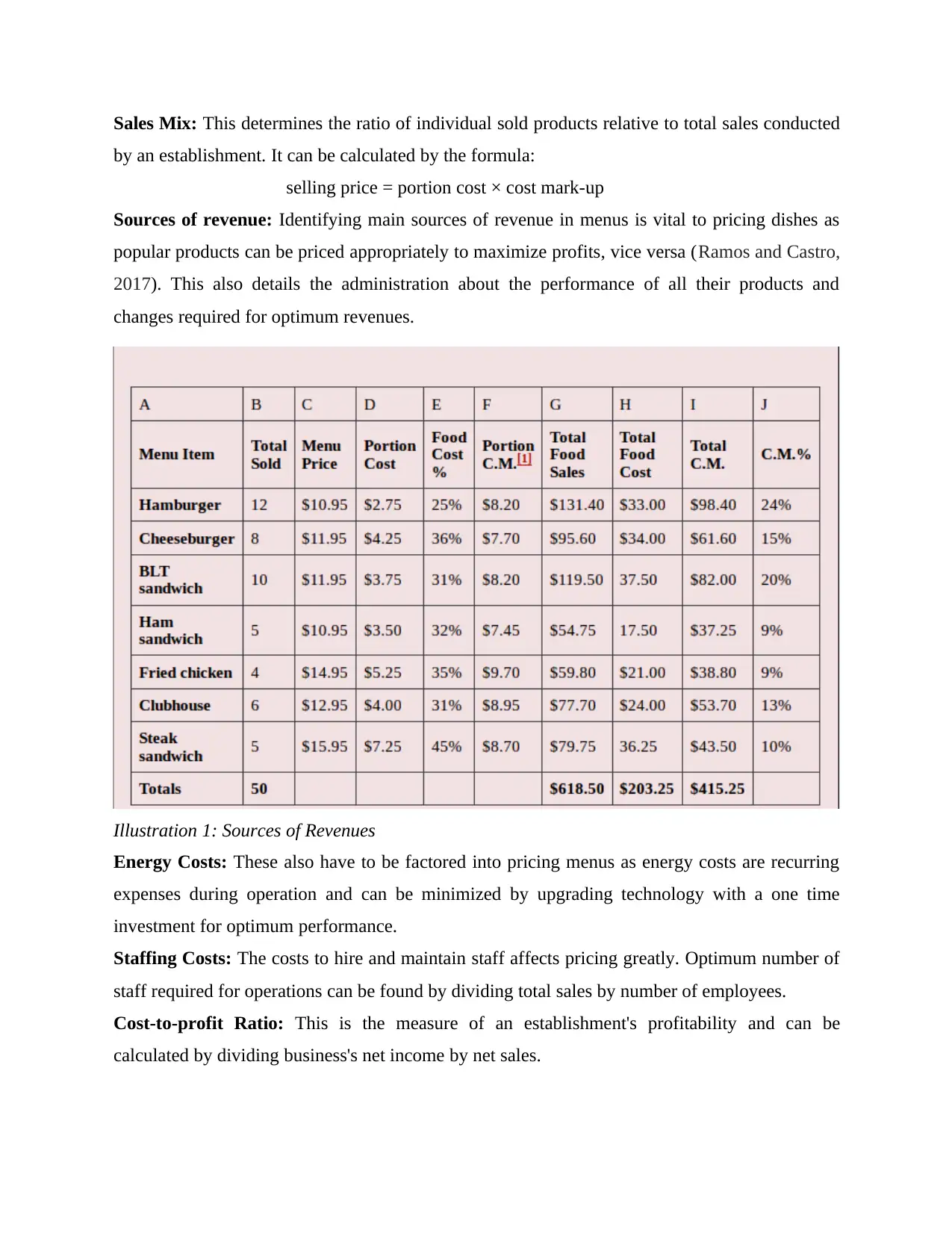
Sales Mix: This determines the ratio of individual sold products relative to total sales conducted
by an establishment. It can be calculated by the formula:
selling price = portion cost × cost mark-up
Sources of revenue: Identifying main sources of revenue in menus is vital to pricing dishes as
popular products can be priced appropriately to maximize profits, vice versa (Ramos and Castro,
2017). This also details the administration about the performance of all their products and
changes required for optimum revenues.
Energy Costs: These also have to be factored into pricing menus as energy costs are recurring
expenses during operation and can be minimized by upgrading technology with a one time
investment for optimum performance.
Staffing Costs: The costs to hire and maintain staff affects pricing greatly. Optimum number of
staff required for operations can be found by dividing total sales by number of employees.
Cost-to-profit Ratio: This is the measure of an establishment's profitability and can be
calculated by dividing business's net income by net sales.
Illustration 1: Sources of Revenues
by an establishment. It can be calculated by the formula:
selling price = portion cost × cost mark-up
Sources of revenue: Identifying main sources of revenue in menus is vital to pricing dishes as
popular products can be priced appropriately to maximize profits, vice versa (Ramos and Castro,
2017). This also details the administration about the performance of all their products and
changes required for optimum revenues.
Energy Costs: These also have to be factored into pricing menus as energy costs are recurring
expenses during operation and can be minimized by upgrading technology with a one time
investment for optimum performance.
Staffing Costs: The costs to hire and maintain staff affects pricing greatly. Optimum number of
staff required for operations can be found by dividing total sales by number of employees.
Cost-to-profit Ratio: This is the measure of an establishment's profitability and can be
calculated by dividing business's net income by net sales.
Illustration 1: Sources of Revenues

Produce costs: Costs of input seasonal produce also affects the pricing of menus as fluctuations
in these costs affect operations and potential profits. Final costs are calculated by adding markup
costs to existing production costs.
in these costs affect operations and potential profits. Final costs are calculated by adding markup
costs to existing production costs.
Paraphrase This Document
Need a fresh take? Get an instant paraphrase of this document with our AI Paraphraser
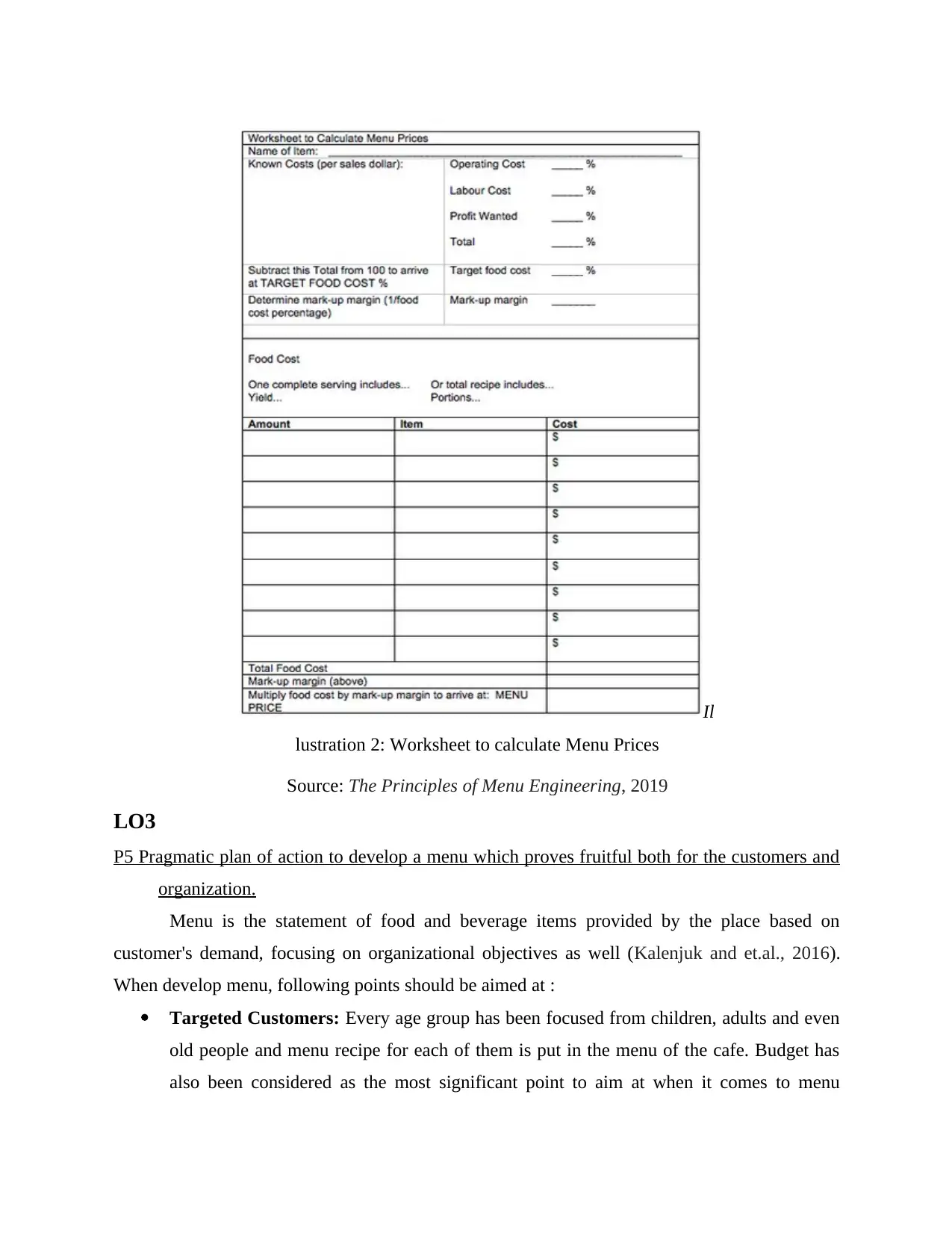
LO3
P5 Pragmatic plan of action to develop a menu which proves fruitful both for the customers and
organization.
Menu is the statement of food and beverage items provided by the place based on
customer's demand, focusing on organizational objectives as well (Kalenjuk and et.al., 2016).
When develop menu, following points should be aimed at :
Targeted Customers: Every age group has been focused from children, adults and even
old people and menu recipe for each of them is put in the menu of the cafe. Budget has
also been considered as the most significant point to aim at when it comes to menu
Il
lustration 2: Worksheet to calculate Menu Prices
Source: The Principles of Menu Engineering, 2019
P5 Pragmatic plan of action to develop a menu which proves fruitful both for the customers and
organization.
Menu is the statement of food and beverage items provided by the place based on
customer's demand, focusing on organizational objectives as well (Kalenjuk and et.al., 2016).
When develop menu, following points should be aimed at :
Targeted Customers: Every age group has been focused from children, adults and even
old people and menu recipe for each of them is put in the menu of the cafe. Budget has
also been considered as the most significant point to aim at when it comes to menu
Il
lustration 2: Worksheet to calculate Menu Prices
Source: The Principles of Menu Engineering, 2019
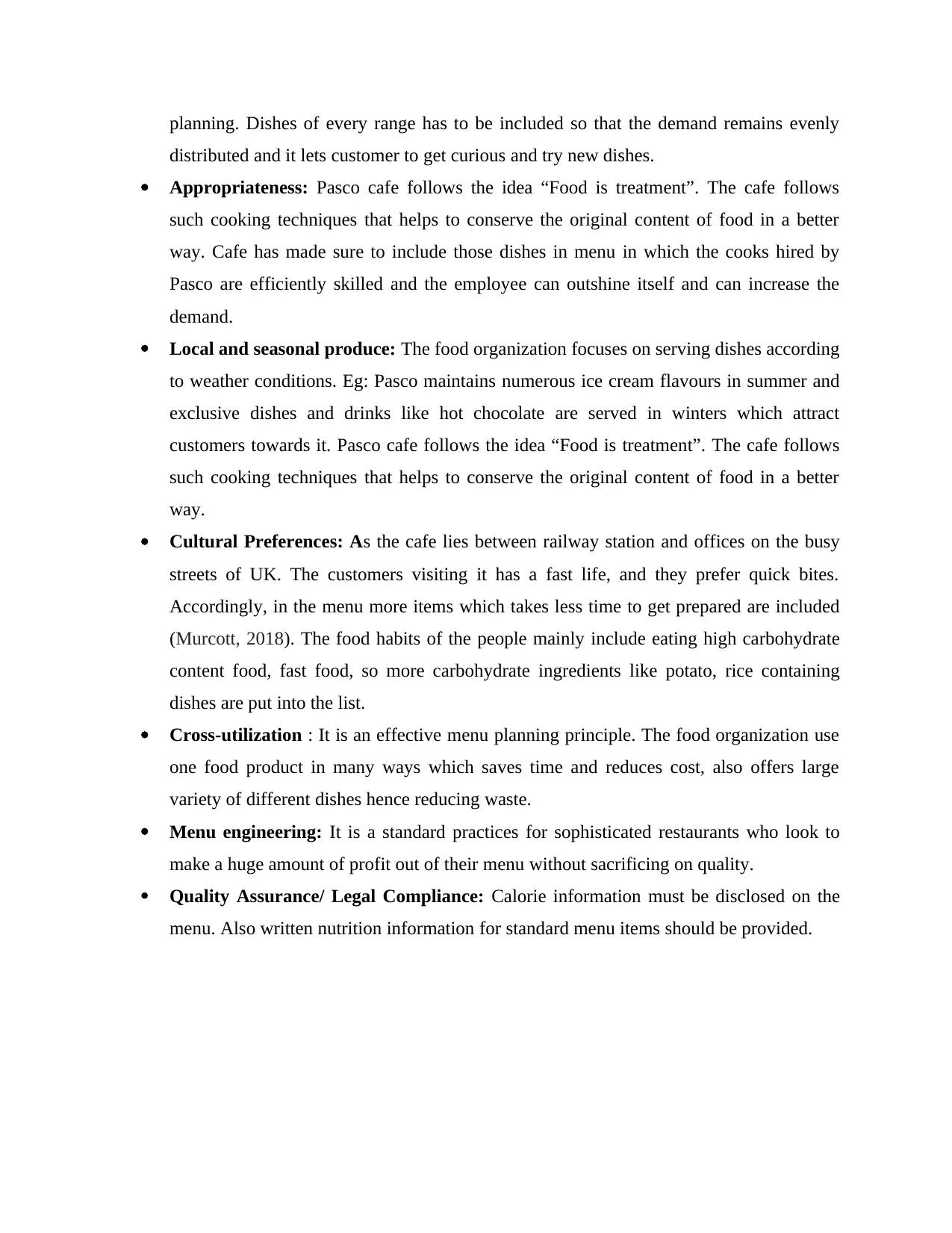
planning. Dishes of every range has to be included so that the demand remains evenly
distributed and it lets customer to get curious and try new dishes.
Appropriateness: Pasco cafe follows the idea “Food is treatment”. The cafe follows
such cooking techniques that helps to conserve the original content of food in a better
way. Cafe has made sure to include those dishes in menu in which the cooks hired by
Pasco are efficiently skilled and the employee can outshine itself and can increase the
demand.
Local and seasonal produce: The food organization focuses on serving dishes according
to weather conditions. Eg: Pasco maintains numerous ice cream flavours in summer and
exclusive dishes and drinks like hot chocolate are served in winters which attract
customers towards it. Pasco cafe follows the idea “Food is treatment”. The cafe follows
such cooking techniques that helps to conserve the original content of food in a better
way.
Cultural Preferences: As the cafe lies between railway station and offices on the busy
streets of UK. The customers visiting it has a fast life, and they prefer quick bites.
Accordingly, in the menu more items which takes less time to get prepared are included
(Murcott, 2018). The food habits of the people mainly include eating high carbohydrate
content food, fast food, so more carbohydrate ingredients like potato, rice containing
dishes are put into the list.
Cross-utilization : It is an effective menu planning principle. The food organization use
one food product in many ways which saves time and reduces cost, also offers large
variety of different dishes hence reducing waste.
Menu engineering: It is a standard practices for sophisticated restaurants who look to
make a huge amount of profit out of their menu without sacrificing on quality.
Quality Assurance/ Legal Compliance: Calorie information must be disclosed on the
menu. Also written nutrition information for standard menu items should be provided.
distributed and it lets customer to get curious and try new dishes.
Appropriateness: Pasco cafe follows the idea “Food is treatment”. The cafe follows
such cooking techniques that helps to conserve the original content of food in a better
way. Cafe has made sure to include those dishes in menu in which the cooks hired by
Pasco are efficiently skilled and the employee can outshine itself and can increase the
demand.
Local and seasonal produce: The food organization focuses on serving dishes according
to weather conditions. Eg: Pasco maintains numerous ice cream flavours in summer and
exclusive dishes and drinks like hot chocolate are served in winters which attract
customers towards it. Pasco cafe follows the idea “Food is treatment”. The cafe follows
such cooking techniques that helps to conserve the original content of food in a better
way.
Cultural Preferences: As the cafe lies between railway station and offices on the busy
streets of UK. The customers visiting it has a fast life, and they prefer quick bites.
Accordingly, in the menu more items which takes less time to get prepared are included
(Murcott, 2018). The food habits of the people mainly include eating high carbohydrate
content food, fast food, so more carbohydrate ingredients like potato, rice containing
dishes are put into the list.
Cross-utilization : It is an effective menu planning principle. The food organization use
one food product in many ways which saves time and reduces cost, also offers large
variety of different dishes hence reducing waste.
Menu engineering: It is a standard practices for sophisticated restaurants who look to
make a huge amount of profit out of their menu without sacrificing on quality.
Quality Assurance/ Legal Compliance: Calorie information must be disclosed on the
menu. Also written nutrition information for standard menu items should be provided.
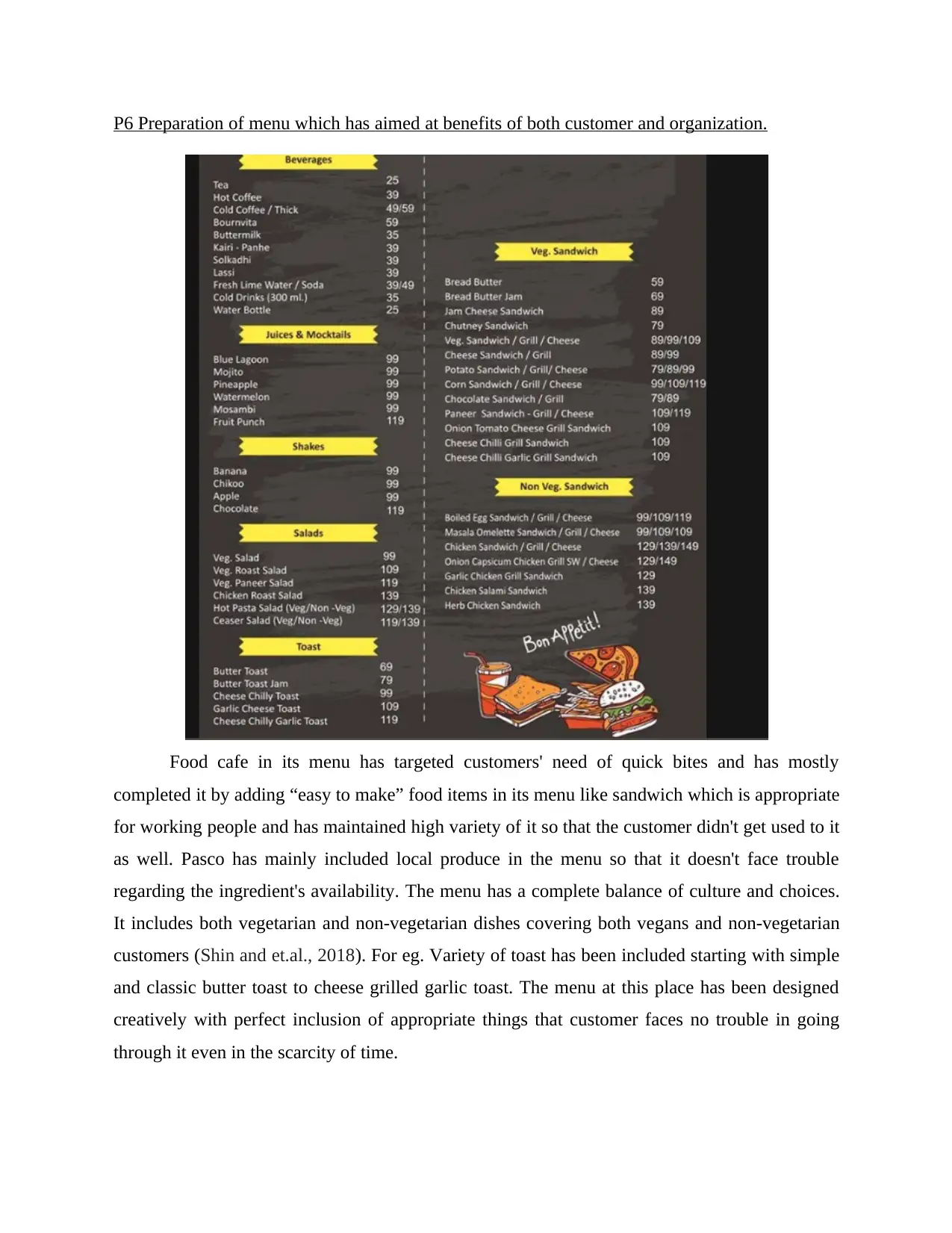
P6 Preparation of menu which has aimed at benefits of both customer and organization.
Food cafe in its menu has targeted customers' need of quick bites and has mostly
completed it by adding “easy to make” food items in its menu like sandwich which is appropriate
for working people and has maintained high variety of it so that the customer didn't get used to it
as well. Pasco has mainly included local produce in the menu so that it doesn't face trouble
regarding the ingredient's availability. The menu has a complete balance of culture and choices.
It includes both vegetarian and non-vegetarian dishes covering both vegans and non-vegetarian
customers (Shin and et.al., 2018). For eg. Variety of toast has been included starting with simple
and classic butter toast to cheese grilled garlic toast. The menu at this place has been designed
creatively with perfect inclusion of appropriate things that customer faces no trouble in going
through it even in the scarcity of time.
Food cafe in its menu has targeted customers' need of quick bites and has mostly
completed it by adding “easy to make” food items in its menu like sandwich which is appropriate
for working people and has maintained high variety of it so that the customer didn't get used to it
as well. Pasco has mainly included local produce in the menu so that it doesn't face trouble
regarding the ingredient's availability. The menu has a complete balance of culture and choices.
It includes both vegetarian and non-vegetarian dishes covering both vegans and non-vegetarian
customers (Shin and et.al., 2018). For eg. Variety of toast has been included starting with simple
and classic butter toast to cheese grilled garlic toast. The menu at this place has been designed
creatively with perfect inclusion of appropriate things that customer faces no trouble in going
through it even in the scarcity of time.
Secure Best Marks with AI Grader
Need help grading? Try our AI Grader for instant feedback on your assignments.
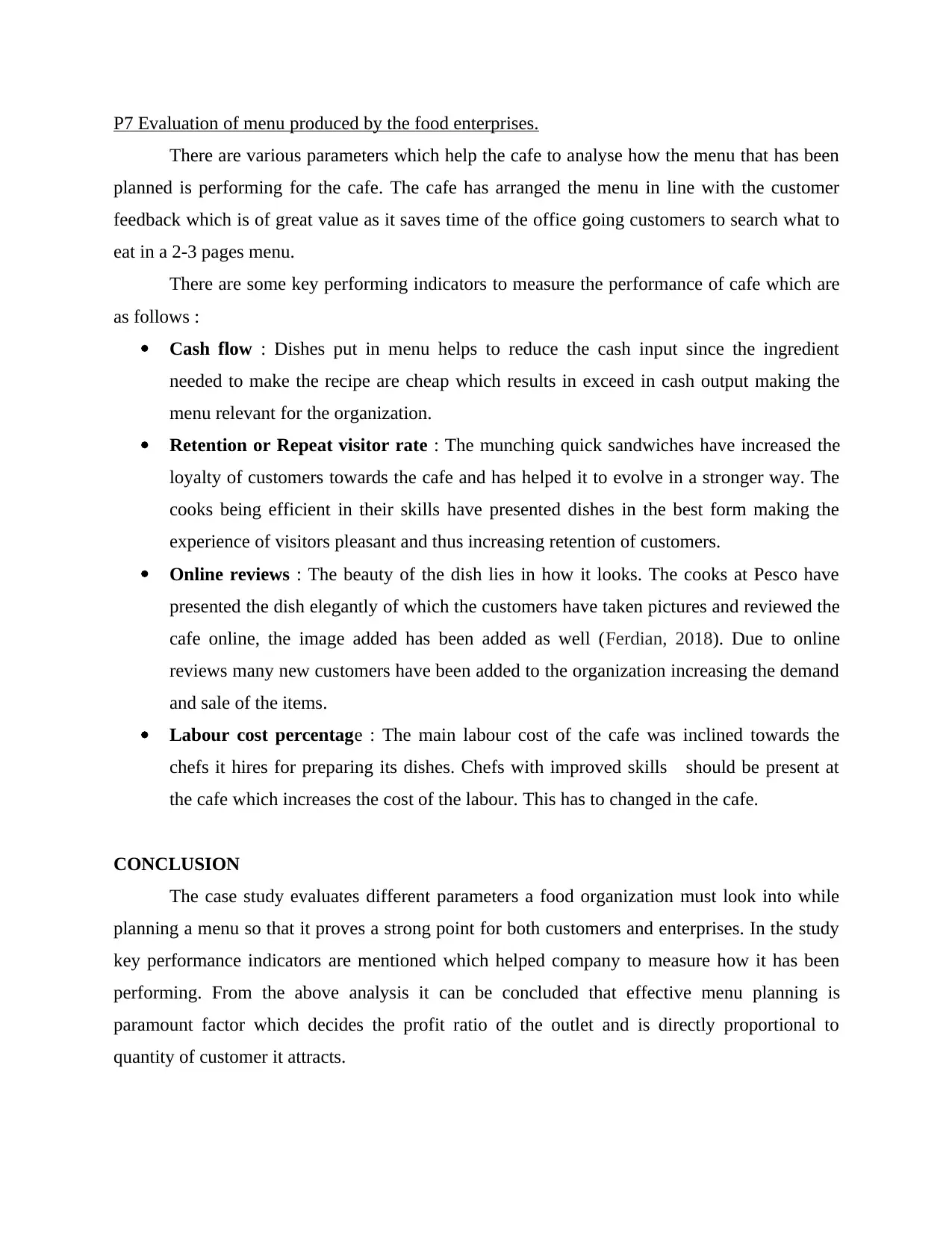
P7 Evaluation of menu produced by the food enterprises.
There are various parameters which help the cafe to analyse how the menu that has been
planned is performing for the cafe. The cafe has arranged the menu in line with the customer
feedback which is of great value as it saves time of the office going customers to search what to
eat in a 2-3 pages menu.
There are some key performing indicators to measure the performance of cafe which are
as follows :
Cash flow : Dishes put in menu helps to reduce the cash input since the ingredient
needed to make the recipe are cheap which results in exceed in cash output making the
menu relevant for the organization.
Retention or Repeat visitor rate : The munching quick sandwiches have increased the
loyalty of customers towards the cafe and has helped it to evolve in a stronger way. The
cooks being efficient in their skills have presented dishes in the best form making the
experience of visitors pleasant and thus increasing retention of customers.
Online reviews : The beauty of the dish lies in how it looks. The cooks at Pesco have
presented the dish elegantly of which the customers have taken pictures and reviewed the
cafe online, the image added has been added as well (Ferdian, 2018). Due to online
reviews many new customers have been added to the organization increasing the demand
and sale of the items.
Labour cost percentage : The main labour cost of the cafe was inclined towards the
chefs it hires for preparing its dishes. Chefs with improved skills should be present at
the cafe which increases the cost of the labour. This has to changed in the cafe.
CONCLUSION
The case study evaluates different parameters a food organization must look into while
planning a menu so that it proves a strong point for both customers and enterprises. In the study
key performance indicators are mentioned which helped company to measure how it has been
performing. From the above analysis it can be concluded that effective menu planning is
paramount factor which decides the profit ratio of the outlet and is directly proportional to
quantity of customer it attracts.
There are various parameters which help the cafe to analyse how the menu that has been
planned is performing for the cafe. The cafe has arranged the menu in line with the customer
feedback which is of great value as it saves time of the office going customers to search what to
eat in a 2-3 pages menu.
There are some key performing indicators to measure the performance of cafe which are
as follows :
Cash flow : Dishes put in menu helps to reduce the cash input since the ingredient
needed to make the recipe are cheap which results in exceed in cash output making the
menu relevant for the organization.
Retention or Repeat visitor rate : The munching quick sandwiches have increased the
loyalty of customers towards the cafe and has helped it to evolve in a stronger way. The
cooks being efficient in their skills have presented dishes in the best form making the
experience of visitors pleasant and thus increasing retention of customers.
Online reviews : The beauty of the dish lies in how it looks. The cooks at Pesco have
presented the dish elegantly of which the customers have taken pictures and reviewed the
cafe online, the image added has been added as well (Ferdian, 2018). Due to online
reviews many new customers have been added to the organization increasing the demand
and sale of the items.
Labour cost percentage : The main labour cost of the cafe was inclined towards the
chefs it hires for preparing its dishes. Chefs with improved skills should be present at
the cafe which increases the cost of the labour. This has to changed in the cafe.
CONCLUSION
The case study evaluates different parameters a food organization must look into while
planning a menu so that it proves a strong point for both customers and enterprises. In the study
key performance indicators are mentioned which helped company to measure how it has been
performing. From the above analysis it can be concluded that effective menu planning is
paramount factor which decides the profit ratio of the outlet and is directly proportional to
quantity of customer it attracts.
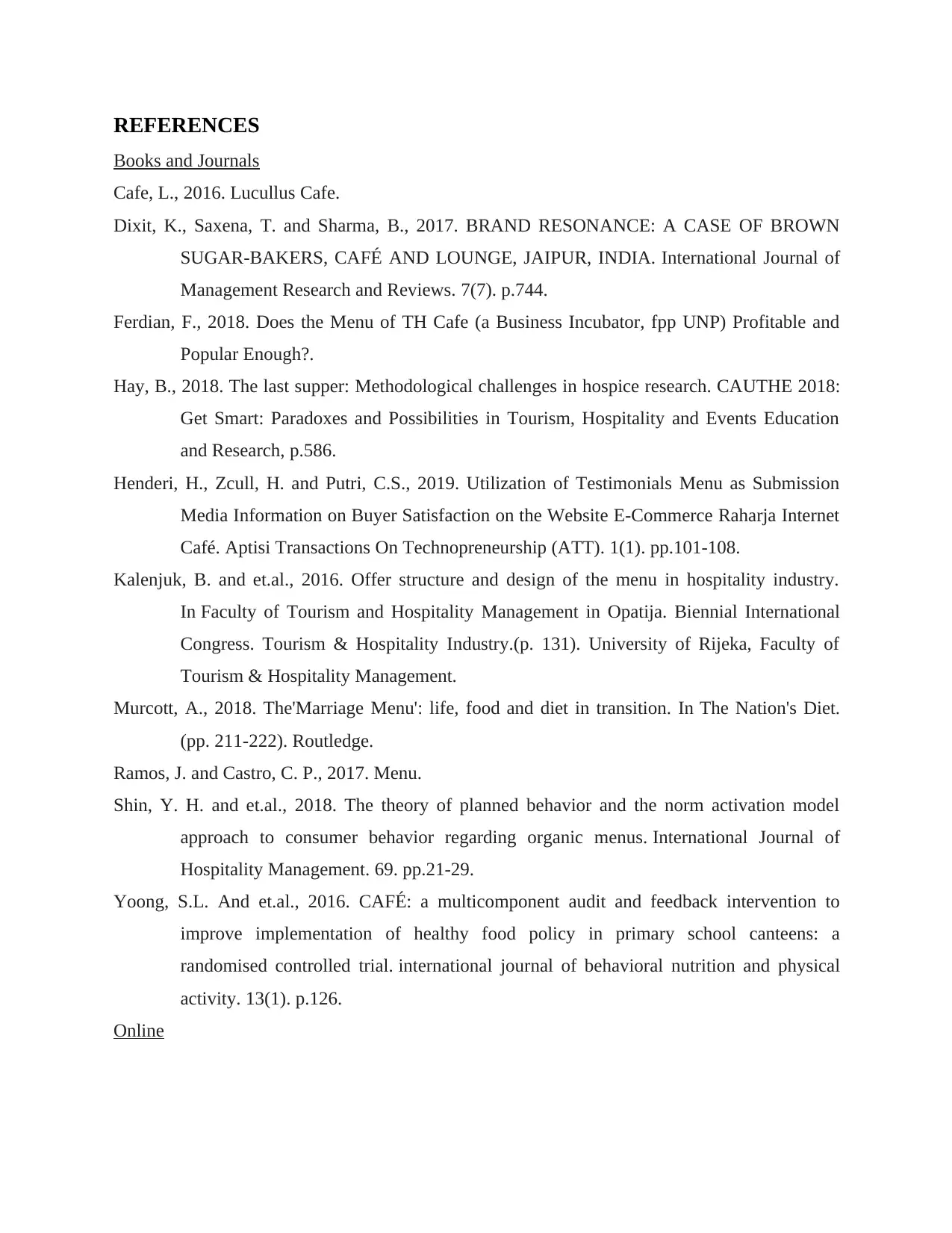
REFERENCES
Books and Journals
Cafe, L., 2016. Lucullus Cafe.
Dixit, K., Saxena, T. and Sharma, B., 2017. BRAND RESONANCE: A CASE OF BROWN
SUGAR-BAKERS, CAFÉ AND LOUNGE, JAIPUR, INDIA. International Journal of
Management Research and Reviews. 7(7). p.744.
Ferdian, F., 2018. Does the Menu of TH Cafe (a Business Incubator, fpp UNP) Profitable and
Popular Enough?.
Hay, B., 2018. The last supper: Methodological challenges in hospice research. CAUTHE 2018:
Get Smart: Paradoxes and Possibilities in Tourism, Hospitality and Events Education
and Research, p.586.
Henderi, H., Zcull, H. and Putri, C.S., 2019. Utilization of Testimonials Menu as Submission
Media Information on Buyer Satisfaction on the Website E-Commerce Raharja Internet
Café. Aptisi Transactions On Technopreneurship (ATT). 1(1). pp.101-108.
Kalenjuk, B. and et.al., 2016. Offer structure and design of the menu in hospitality industry.
In Faculty of Tourism and Hospitality Management in Opatija. Biennial International
Congress. Tourism & Hospitality Industry.(p. 131). University of Rijeka, Faculty of
Tourism & Hospitality Management.
Murcott, A., 2018. The'Marriage Menu': life, food and diet in transition. In The Nation's Diet.
(pp. 211-222). Routledge.
Ramos, J. and Castro, C. P., 2017. Menu.
Shin, Y. H. and et.al., 2018. The theory of planned behavior and the norm activation model
approach to consumer behavior regarding organic menus. International Journal of
Hospitality Management. 69. pp.21-29.
Yoong, S.L. And et.al., 2016. CAFÉ: a multicomponent audit and feedback intervention to
improve implementation of healthy food policy in primary school canteens: a
randomised controlled trial. international journal of behavioral nutrition and physical
activity. 13(1). p.126.
Online
Books and Journals
Cafe, L., 2016. Lucullus Cafe.
Dixit, K., Saxena, T. and Sharma, B., 2017. BRAND RESONANCE: A CASE OF BROWN
SUGAR-BAKERS, CAFÉ AND LOUNGE, JAIPUR, INDIA. International Journal of
Management Research and Reviews. 7(7). p.744.
Ferdian, F., 2018. Does the Menu of TH Cafe (a Business Incubator, fpp UNP) Profitable and
Popular Enough?.
Hay, B., 2018. The last supper: Methodological challenges in hospice research. CAUTHE 2018:
Get Smart: Paradoxes and Possibilities in Tourism, Hospitality and Events Education
and Research, p.586.
Henderi, H., Zcull, H. and Putri, C.S., 2019. Utilization of Testimonials Menu as Submission
Media Information on Buyer Satisfaction on the Website E-Commerce Raharja Internet
Café. Aptisi Transactions On Technopreneurship (ATT). 1(1). pp.101-108.
Kalenjuk, B. and et.al., 2016. Offer structure and design of the menu in hospitality industry.
In Faculty of Tourism and Hospitality Management in Opatija. Biennial International
Congress. Tourism & Hospitality Industry.(p. 131). University of Rijeka, Faculty of
Tourism & Hospitality Management.
Murcott, A., 2018. The'Marriage Menu': life, food and diet in transition. In The Nation's Diet.
(pp. 211-222). Routledge.
Ramos, J. and Castro, C. P., 2017. Menu.
Shin, Y. H. and et.al., 2018. The theory of planned behavior and the norm activation model
approach to consumer behavior regarding organic menus. International Journal of
Hospitality Management. 69. pp.21-29.
Yoong, S.L. And et.al., 2016. CAFÉ: a multicomponent audit and feedback intervention to
improve implementation of healthy food policy in primary school canteens: a
randomised controlled trial. international journal of behavioral nutrition and physical
activity. 13(1). p.126.
Online

The Principles of Menu Engineering. 2019. [ONLINE] Available through:
<https://opentextbc.ca/basickitchenandfoodservicemanagement/chapter/describe-the-
principles-of-menu-engineering/#return-footnote-351-1>
<https://opentextbc.ca/basickitchenandfoodservicemanagement/chapter/describe-the-
principles-of-menu-engineering/#return-footnote-351-1>
1 out of 13
Related Documents
Your All-in-One AI-Powered Toolkit for Academic Success.
+13062052269
info@desklib.com
Available 24*7 on WhatsApp / Email
![[object Object]](/_next/static/media/star-bottom.7253800d.svg)
Unlock your academic potential
© 2024 | Zucol Services PVT LTD | All rights reserved.





